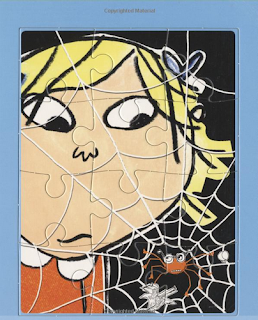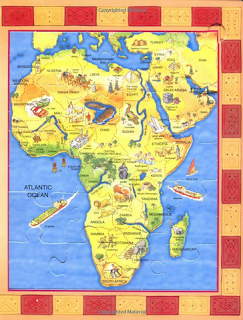At first I was interested in doing A Brief History Of Cameras, and I was thinking of different forms I could look at.
(drawings)
I thought it would be a good idea to do a jigsaw in the shape of a camera, or have a timeline as the content.
Jigsaw Puzzle Book
I then thought a good idea to look at would be jigsaw puzzle book. These are mainly aimed at children, and I would be able to get more content in a book.
The Gruffalo Jigsaw Book
Although I could only see the front page, back page and one jigsaw page, it gave me an idea of how it could look, and that actually there are quite a lot of similar books like this.
The Gruffalo's Child Jigsaw Book
Here is another Gruffalo puzzle book.
I noticed that in the comments a bad point about it was that there was no smaller picture, or picture behind the jigsaw, so children found it hard to start off with what they were supposed to be making.
This review by a mother states that both her 10 year old daughter, and 5 year old son like the book, so jigsaw books appeal to a wide range of children.
Stock
I was thinking about different stocks that I could use for the book, as it would have to be durable, thick and be able to lasercut.
Foamboard
As foamboard is quite thick but soft, it would be easy to cut the jigsaw pieces out, and I could either screenprint or spraymount the text on. However, as it would be for children, I don't think it is the best idea because it would be easy to rip it, and bend it.
Puzzle Mats
These are similar to foamboard, but a lot thicker, so I think that is why they're durable.
Wood
They can also be made out of wood, which I think is a good idea because it would be very durable, and would look good. I would be able to laser cut the jigsaw, and even illustrations like this.
This is a jigsaw book made out of wood, and I think it has a really good finish. It also has a space in the corner of the jigsaw, making it easier for children to get out the pieces.
Cardboard
Puzzles are usually made out of strong cardboard, so this could be a possibility to make the book out of, and from the examples I looked at, most books seem to be made of this.
I looked at how jigsaw puzzles are made:
Raw Materials
Graphics/artwork
Virtually any artwork can be used for puzzle making but most major manufactures use lithographic prints because they are high quality, inexpensive, and easily mass produced. Many of the pictures used in puzzles are based on famous photographs or paintings, but some custom puzzle makers let the customer supply their own photographs or pictures.
Backing material
Mass market puzzle manufacturers use card-board (also known as chipboard) as a backing material because it is cheap and easy to cut. Higher quality custom-made puzzles still use wood, usually in 5-ply birch. In both cases, adhesive is used to bond the artwork to the backing material.
Cutting equipment
The original wood puzzles were cut with jigsaws, also known as scroll saws, and customized wooden puzzles are still made that way today. These saws have a vertical blade that goes up and down through a fixed horizontal table. The puzzle sheet is guided through the blade by hand to cut the desired pieces. The blades used today are very fine, about 0.016 in (0.041 cm) thick. This allows intricate cuts to be made, which take out very little wood, so the puzzles fit together well. It also leaves a very smooth edge surface, with only a minimum of chipping and fuzzing on the back, which can be sanded off. The majority of puzzles today, however, are the cardboard-backed types and these are mass-produced with die cutting equipment.
Design
Puzzle design varies depending on the type of artwork and the style of puzzle desired. The design of the cuts is hand drawn by artists and, consequently, no two puzzles are alike. Quality puzzles are designed to artfully combine the picture with the design of the cut pieces to enhance the enjoyment of the user. Puzzle artists are cautious in their design not to cut through major features of the artwork such as a person's face. The artists control the puzzle's skill level by varying the number of pieces and the complexity of the cuts. Typically, the more pieces the puzzle is cut into, the more difficult it is to assemble. Some puzzle makers make their puzzles even harder to assemble by avoiding straight-edged border pieces. The lack of a straight border makes the edge pieces harder to locate.
Read more: http://www.madehow.com/Volume-4/Jigsaw-Puzzle.html#ixzz2NX0LzYOP
I think I could alter this to laser cut the puzzle, and print it using screen printing. It is useful to know that I should make sure the puzzle pieces don't cut through main parts of the image. It says adhesive is used to stick the artwork to the backing material, but I think laser cutting is also an option as I think it would make for a cleaner finish.
Binding
I'm not really sure what the best way of binding would be for this, I looked at a couple different ways I think might work.
Coptic binding
I looked at this because the cover is usually wooden, so I thought I might be able to use it for wooden pages as well.
Ring binding
I thought ring binding would be a good option, because it would allow the pages to lay flat, so it would be easier to do the jigsaw puzzle.
Content
I thought it could be a good idea to have 'A Brief History of a Pinhole Camera', and on each page have instructions of how to make one, then the puzzle would be an image to go with the tutorial, and at the end would be a net of a pinhole camera so that you could make your own.
I found several websites that include tutorials.
A tutorial of a pinhole camera was published in a magazine in Russia, An ABC of Young Technicians and Natural Scientists. It was called Dirkin, and someone had uploaded the tutorial but it seems incredibly complicated, especially for a child.
I then found a tutorial which seemed a lot easier - you print the whole net on A4, whereas the previous one was on two pages.
I've read through it, and I think the instructions are really simple and clear, and most of all it looks easy to do. I think with adult supervision, a child could have fun creating this.
I also thought maybe it doesn't have to be for children, but could be aimed at young creative people who love photography and crafts, and it would be ideal for a gift, but then I wouldn't use the jigsaw idea as well.
Types of Cameras
Digital camera
Toy camera
Pinhole camera
SLR camera
Polaroid
Brownie
Kodak
Medium Format (Hasselblad)
Project Proposal
I intend to explore the relationship between:
Different cameras that have been invented over time
The technical aspect of making a camera (make your own pinhole)
How the inventions affected society and how it was recorded
I intend to (inform/instruct/persuade/direct/educate/promote):
I intend to instruct and educate people about the different cameras and advancements that came before the modern day digital camera, and how to make your own working camera, so that they know how it works.
... a group of (identify your specific audience or context):
I would like to either aim at children (the jigsaw puzzle book concept), to be read with an adult, as I think that using the jigsaw would be a way of engaging them and getting them to interact with something that they might not necessarily have been interested in otherwise. If I didn't do the jigsaw puzzle idea, but kept the making your own pinhole camera, I would aim it at creative individuals, probably 16-25 year olds, who are interested in creating something themselves and in photography.
... that (message/idea/concept):
The concept that I have is to have a make your own pinhole camera kit within a book, so that when people read about the different cameras in the book, it will sink in to them how it works and how to use it, because they will make their own, rather than just read about it. If I use the jigsaw puzzle book it will encourage children to think about what they are learning, cause they will have to think about the picture they are trying to put together.
In order to achieve this I will produce:
I wanted to make a jigsaw puzzle book which could be made out of wood or cardboard - I'm not really sure which stock would be best. I would use the lasercutter to make the shape of the jigsaws, and possibly the net for the pinhole camera. I might screenprint or letterpress it, depending on what stock I use, as it might not be able to be printed on.




























Leave your comment